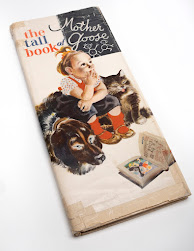Mother Goose may refer to an American woman, Elizabeth Goose--but it's unlikely. The term--Mere Oye--was common in France in the seventeenth century as a reference to a well-known tale or, rather, a well-known tale-bearer. Within context, the term resembles "urban legend," a tale that is told and retold so often, it takes on a life of its own.
 The fascinating aspect of Mother Goose is how often the rhymes are presented in an unusual fashion. Of the books, I checked out, the most traditional is nevertheless presented in an atypical format: The Tall Book of Mother Goose.
The fascinating aspect of Mother Goose is how often the rhymes are presented in an unusual fashion. Of the books, I checked out, the most traditional is nevertheless presented in an atypical format: The Tall Book of Mother Goose.
The Charles Addams Mother Goose, praised by Stephen King, presents the tales with dark twists. My favorite is the spoof of American Gothic. The rhyme is "Three Blind Mice."
And Jon Scieszka has created the deconstructionist version, The Real Dada Mother Goose, in which a single rhyme is presented in multiple ways. "Jack Be Nimble" is presented in Esperanto and then with Bad Libs. "Hey Diddle Diddle" has a news article, recipe, and haiku version. "Twinkle Twinkle" presents a scientific version:
Twinkle, twinkle, little star. Now we know just what you are. A luminous ball of gas, mostly hydrogen and helium, held together by your own gravity, producing light and heat from nuclear fusion reactions in your core. Twinkle, twinkle, little star. Now we know just what you are.
My favorite is "Old Mother Hubbard," the "Re-Verb" version: "Old Mother Hubbard moseyed/progressed/skipped/hightailed it/took a hike to the cupboard."
And, of course, there is a "Censored" Humpty Dumpty version.
By their nature, the rhymes belong to the darker tradition of fairy tales. Agatha Christie used a number either as titles or as both titles and clues. A Pocketful of Rye kills off the "king," "queen," and literal maid in a matter of days.
Children are morbid creatures.




No comments:
Post a Comment